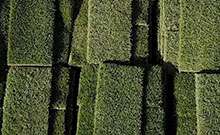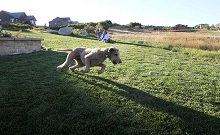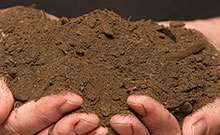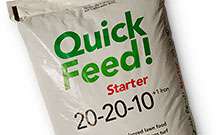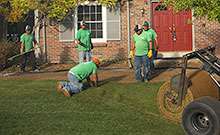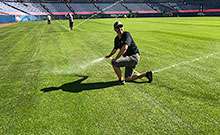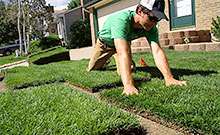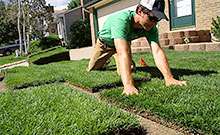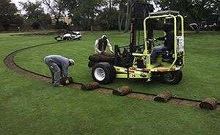Four Steps to Success With Your Spring Lawn
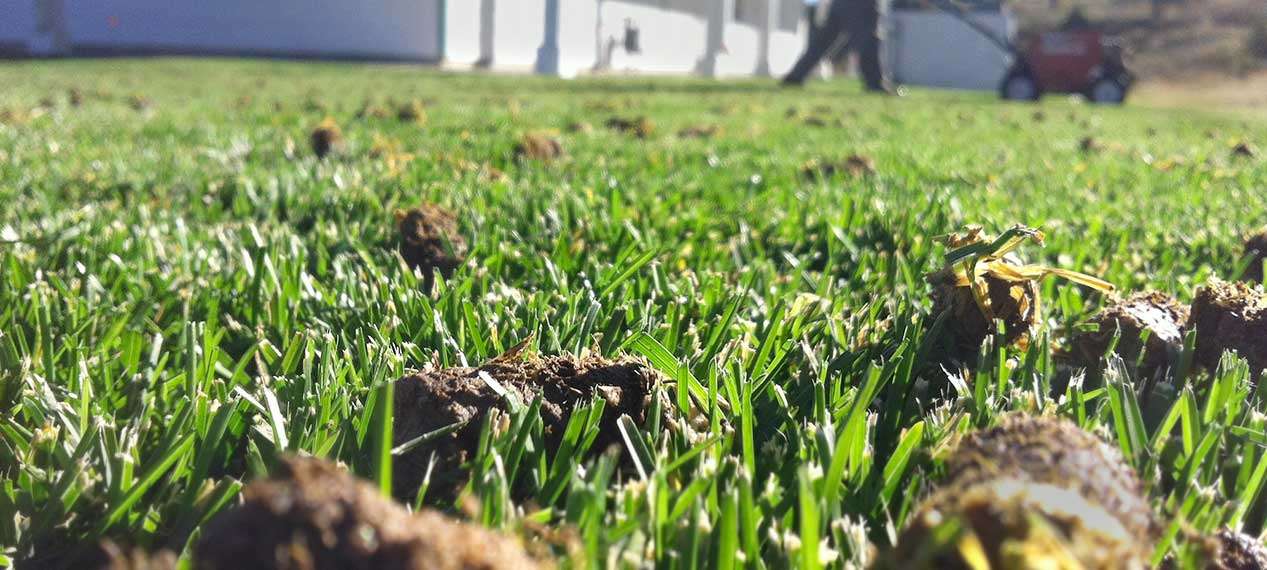
Happy Spring! The sun is starting to come out, everything is beginning to green up, and we’re starting to get those beautiful fleeting days of perfect weather — in between the record breaking blizzards of course! Spring is the perfect time to start waking up your lawn and giving it a little extra love before the heat of the summer really kicks in. By spending a little more energy on your lawn in the spring, you can set it up for success in the coming months. Here are our 4 steps to success with your spring lawn!
1. Aerate
Aeration is an important part of spring lawn maintenance because it opens up the soil. This allows your lawn to get more of the essential nutrients it needs to thrive. Aeration also helps to reduce thatch. Thatch is the layer of decomposing organic matter that settles just above the ground. The combo of thatch and hard, compact soil are especially prevalent after winter when your lawn has been dormant and packed with snow for several months. This combo of thatch and hard soil can suffocate the grass and prohibit oxygen and water from penetrating into the soil if it’s not managed regularly.
You never want to aerate a dormant lawn, but aerating during the spring months when there is active growth helps your lawn recover more quickly and strengthen itself. Aeration allows an easy flow of oxygen, water, and nutrients to the root system to create a happier, healthier and more resilient lawn. Afterall, your lawn is a living organism and it needs fresh air just like we do!
2. Mow
After you’ve aerated, it’s a good idea to mow your lawn. Mowing helps to thicken your lawn by promoting new growth. It cuts off the dead layer leftover from the winter months of dormancy and gives the new, green grass sprouting room to grow. Plants rely on their leaves to soak up the sunlight in order to perform photosynthesis. They grow much better when there is lots of leafy, green surface area to absorb that light. Cutting your lawn also allows more sunlight to reach the ground, which heats up the soil and stimulates growth.
After you aerate, you are left with dirt plugs in your lawn. By mowing, it helps to dissipate those plugs and can act like a top dressing for your lawn. Top dressing is when you put soil or sand over your existing sod to mix in with the organic matter, or thatch as we discussed above, and dilute that matter so more light can shine through. By breaking up those plugs you are doing just that, which ultimately leads to a thick, healthy, and beautiful lawn.
3. Fertilize
Next, you should fertilize. Fertilizing is a great way to give your lawn the tools it needs to grow stronger, thicker, and root more deeply. Overtime, soil loses its natural nutrients, so fertilizing is really important! By feeding your lawn in the spring, it can flourish and have the strength to withstand the hot and dry summer months. Fertilizer also makes your grass grow more quickly, which helps to thicken your lawn. We recommend our 20-20-10 fertilizer with iron. It covers all of the essential nutrients for plants — nitrogen, phosphate, and potassium to ensure that your lawn gets everything it needs. The added iron helps to maintain that lush green color.
Timing is imperative here as you want to be sure to fertilize when the grass is completely dry. If the blades are wet, the fertilizer can stick to them and will actually burn your lawn instead of nourish it. Make sure to time your fertilizing just before a storm (or turn on your irrigation system afterwards) so that the nutrients melt right into the soil and infiltrate deeply into the ground. By watering after fertilizing, it activates the fertilizer and pushes it into the soil where it can start nourishing your lawn.
4. Water, naturally!
Spring is an amazing time to take advantage of natural precipitation. Rain and snow storms are common and can really help you save on your water bill while making sure your lawn is getting properly watered. When your lawn is waking up it needs to be watered roughly twice a week, so it’s pretty easy to let mother nature do the work here. Make sure you keep your irrigation system off of a timer and only turn them on as needed. You would never want your sprinklers to be on during or around a rain or snowstorm — that’s wasting one of the world’s most valuable resources! Plus, as an added bonus, the water from rain and snow has a lower pH that is actually better for your plants than the city water. So be sure to take advantage of our wet springs!
In summary, by putting in a little extra work with your lawn in the spring, you can help set it up for success in the summer. Aerating and mowing to alleviate compacted soil and reduce thatch helps your lawn breathe and allows an easy exchange of nutrients to the root system. After you’ve opened up the soil, feed your lawn with our 20-20-10 plus iron fertilizer to make sure it has all of the nutrients it needs to grow thick and lush before the stress of hot, dry summer. Then, let mother nature do the rest by giving your lawn plenty of water as it wakes up from its long winter nap. By following these four easy steps, you will help your lawn grow stronger and deeper roots, which ultimately allows it to use less water and grow more resiliently in times of stress. And once again, happy spring!
Ultimate Guide to Spring Lawn Care Steps
Welcome to our comprehensive guide on spring lawn care steps, where we will walk you through everything you need to know to get your lawn spring-ready. As the snow melts away and the first signs of green appear, it's crucial to give your lawn the attention it deserves. Proper lawn care in spring is vital for a lush, healthy lawn all year round.
The Foundation of Spring Lawn Care
Before diving into the specifics, let's understand the foundation of effective spring lawn care steps. These steps are designed to revive your lawn from its winter dormancy and set the stage for robust growth in the coming months.
Step 1: Cleaning and Preparation
The first step in your spring lawn care regimen should be thoroughly cleaning. Remove any debris, leaves, or branches accumulated over the winter. This cleanup prevents disease and pests and allows sunlight and air to reach the grassroots more effectively. Learning about steps for lawn care in spring can provide a great starting point.
Step 2: Aeration and Dethatching
Aeration is a process that involves creating small holes in the soil to allow air, water, and nutrients to penetrate the grass roots. Dethatching, on the other hand, removes the thick layer of dead turfgrass tissue, known as thatch, which can suffocate your lawn. These two processes are vital for a healthy lawn, and understanding successful turf care is key.
Step 3: Overseeding and Fertilization
Overseeding is the process of sowing new grass seeds over existing turf. It helps in filling any bare spots and enhances the lawn's density and color. Following overseeding, a proper fertilization schedule should be adopted. Use a high-quality fertilizer that suits the specific needs of your lawn, considering the local climate and soil conditions. A lawn care pricing calculator can help manage your budget for these projects.
Step 4: Watering and Maintenance
Consistent watering is key to establishing a lush, green lawn. However, be mindful not to overwater, which can lead to root rot and other diseases. Establish a regular mowing schedule, keeping the blades sharp and never cutting more than a third of the grass's height to avoid stress on the lawn. A detailed Colorado lawn care schedule can guide you through this process, even if you're not in Colorado.
Spring lawn care is more than just a series of tasks; it's about setting your lawn up for success throughout the year. By following these steps, you can ensure a healthy, beautiful lawn that is the envy of the neighborhood. Consistency and attention to detail in your lawn care routine are key to achieving the best results.
As the season progresses, keep an eye on your lawn's health and be ready to adjust your care plan as needed. With the right approach, you can enjoy a vibrant, thriving lawn that enhances your home's curb appeal and offers a welcoming outdoor space for you and your family.

